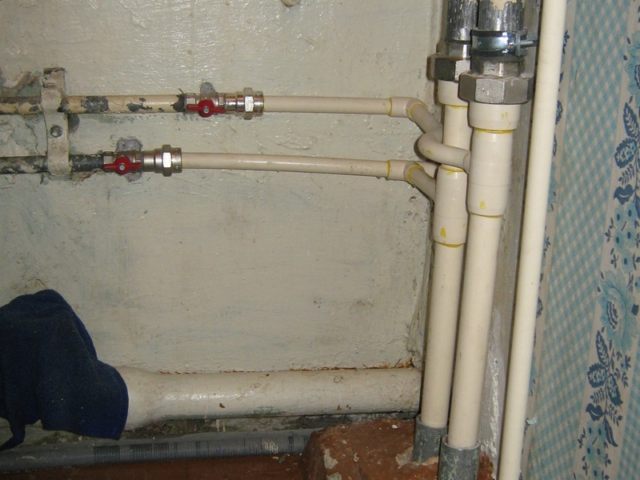On the issue of quality of hot water supply in apartment buildings. Hot water with recirculation
Whoever gets up first, that ... has to drain hot water for a long time to wash. We learned this simple truth thanks to houses built in the mid-20th century.
Towel dryers cooling down in the absence of a water intake and, as a result, a damp and cool bathroom complete the dull picture. Not everyone knows that both problems have long been resolved by engineers. Meet: hot water with recirculation!
Traditional DHW cabling
The device of the hot water supply system in stalinka and early Khrushchev is no different from the layout of cold water. The only bottling ends with dead ends, from which the apartment wiring departs. In the elevator unit, bottling branches into two taps - in the feed and return threads.
DHW switching from supply to return is carried out manually in accordance with the temperature schedule of heating:
- At a temperature of process water at the outlet of the thermal power station up to 80-90 degrees of hot water supply is supplied
- When exceeding 90 ° C, the water supply switches to reverse water supply.
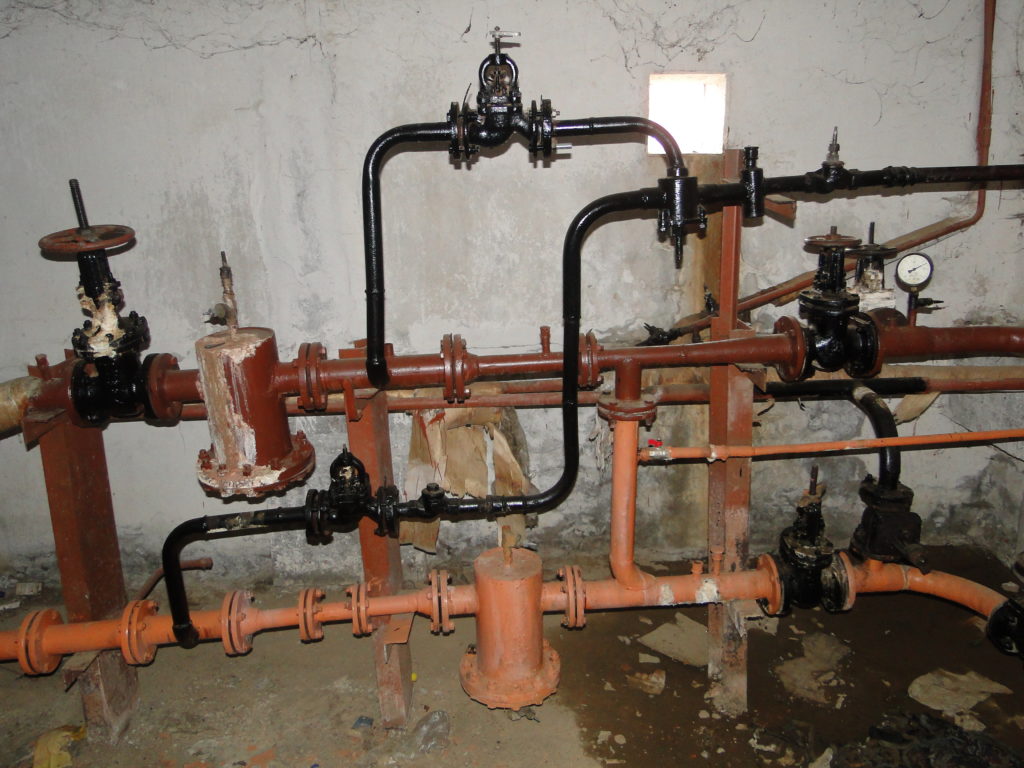
Why is this bad
The advantages of such a scheme are the low cost of implementation and extremely simple maintenance. There are also downsides.
Two of them we have already mentioned:
- Without tapping, the water in the risers and pipelines cools. To wash or take a shower, it takes a long time (up to several minutes) to drain into the sewer. For residents of the apartment, this means not only a loss of time, but also significant costs: in fact, you drain cold water, but if you have a water meter, pay for it like hot water;

Reference: the cost of a cubic meter of hot water in mid-2017 for residents of Moscow is 163 rubles. It is estimated that for a year a family of 3-4 people is drained into the sewer in anticipation of heating water at least 10-12 cubic meters.

- Heated towel rails that open the in-room hot water supply pipes are heated only from the drawdown in your apartment. You can forget about quality bathroom heating.

Let's throw a handful of little things into the general piggy bank of the shortcomings of the solution:
- Cold and damp in the bathroom contribute to the appearance of fungus;

- Towels hung on a cold dryer quickly become musty;
- The cyclic heating and cooling of the DHW risers is accompanied by cycles of their lengthening and size reduction. As a result, the sealing of risers in the ceiling with cement mortar is gradually being destroyed.

Note: elongation of pipes during heating in the event that they touch the ceiling reinforcement may be accompanied by rather loud sounds. In the author’s memory, the friction of the riser against the reinforcement led to a comical situation: tenants accused their riser neighbors of ... clandestine printing of money.
All in white and on a white horse
What is the difference from the hot water recycling system described above? It’s easy to guess. In it, hot water continuously circulates through bottling and (in the case of a multi-storey building) DHW risers.
As a result:
- Instantaneous supply of hot water to the point of tapping on any part of the circuit is provided;
- Towel dryers are transferred from the in-house eyeliner to the riser (or, in the case of a private house, bottling) of hot water. Due to the continuous circulation, they remain hot around the clock, provide heating for bathrooms and bathrooms, and at the same time, quick drying of towels;

- The temperature mode of the DHW system remains stable, without cyclic cooling and heating.
Implementation
What recycling hot water schemes are possible in multi-unit and private houses?
Apartment buildings
To create a continuous circulation of water, the DHW system needs to be looped back.
In apartment buildings, this is achieved as follows:
| Picture | Description |
|
|
Two bottled hot water are bred around the house. The risers connect to them alternately. As an option - only DHW risers are connected to one of the spills, only risers with heated towel rails to the second |
|
|
DHW risers (optionally DHW and heated towel rails) are connected by jumpers on the top floor. A group may combine 2-4 risers. An air vent (Mayevsky crane) is mounted at the upper point of the jumper, which allows the air to obstruct the circulation to be vented. |
Curious: in some houses built in the late 80's, the author observed jumpers between the DHW risers, which were carried out in a cold attic. The decision raises doubts about the adequacy of the authors: at a street temperature of -30 ° C and below, they freeze for an hour after stopping circulation in the DHW system (for example, for emergency repair of a valve in an elevator unit).
It is clear that the described water supply circuit with recirculation will not work without a differential pressure.
How is it provided:
- Outside the heating season, the DHW is switched on between the feed and return threads;
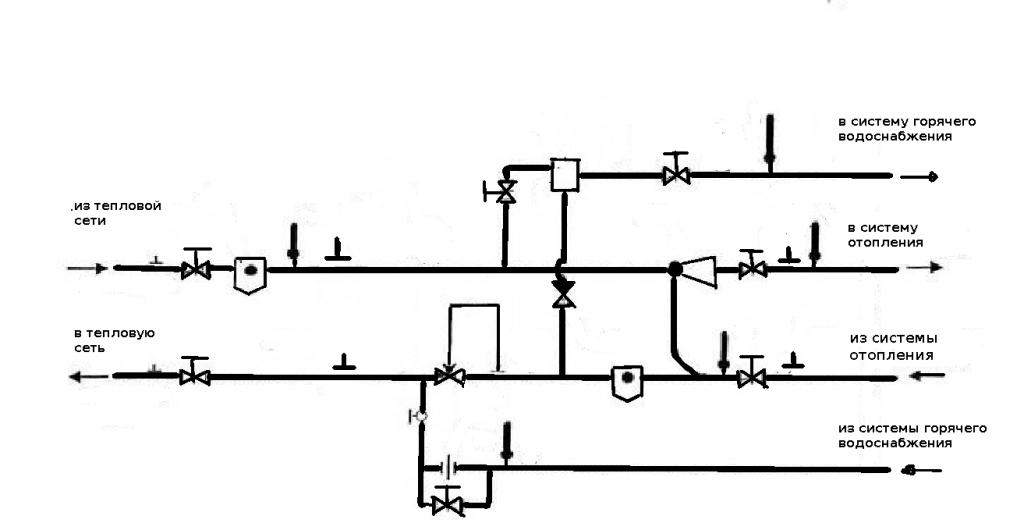
- During heating operation with such a connection, the hot water supply system will be a bypass for the heating system, catastrophically reducing the drop on the water-jet elevator. Therefore, the DHW is connected depending on the temperature of the water from the supply to the supply or from the return to the return, and the differential is provided by retaining washers installed on the flanges between the insets.
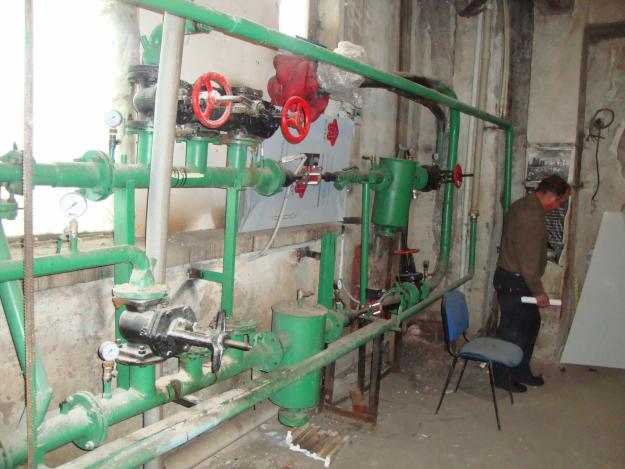
Reference: retaining washer - steel pancake with a hole in the middle. The diameter of the hole is usually 1 mm larger than the diameter of the elevator nozzle. When water moves through the washer, a difference of 0.1-0.3 kgf / cm is created on it, which is quite sufficient for circulation in the DHW system.
If risers are airy
What should I do if, after the hot water system is reset, the remaining air plug in the risers obstructs circulation and the towel warmers remain cold?
To bleed air, a Maevsky crane is used at the upper point of the jumper. However, to access it you need to get into the upper apartment through a riser, which is not always possible.
Here is a simple step-by-step guide to help you fix the problem with your own hands:
- We block any of the DHW risers connected by a jumper;
- We open one to the stop, and better - two hot water taps in any apartment on this riser. An air plug flies through the mixer at the front of the water stream;
![]()
- Run the risers in normal mode.
Private houses
What schemes of recirculation of hot water supply can be implemented in a private house with autonomous preparation of hot water? For creating a circulation pressure in such a system, a circulation pump of minimum power (from 25 watts) will be quite predictable.
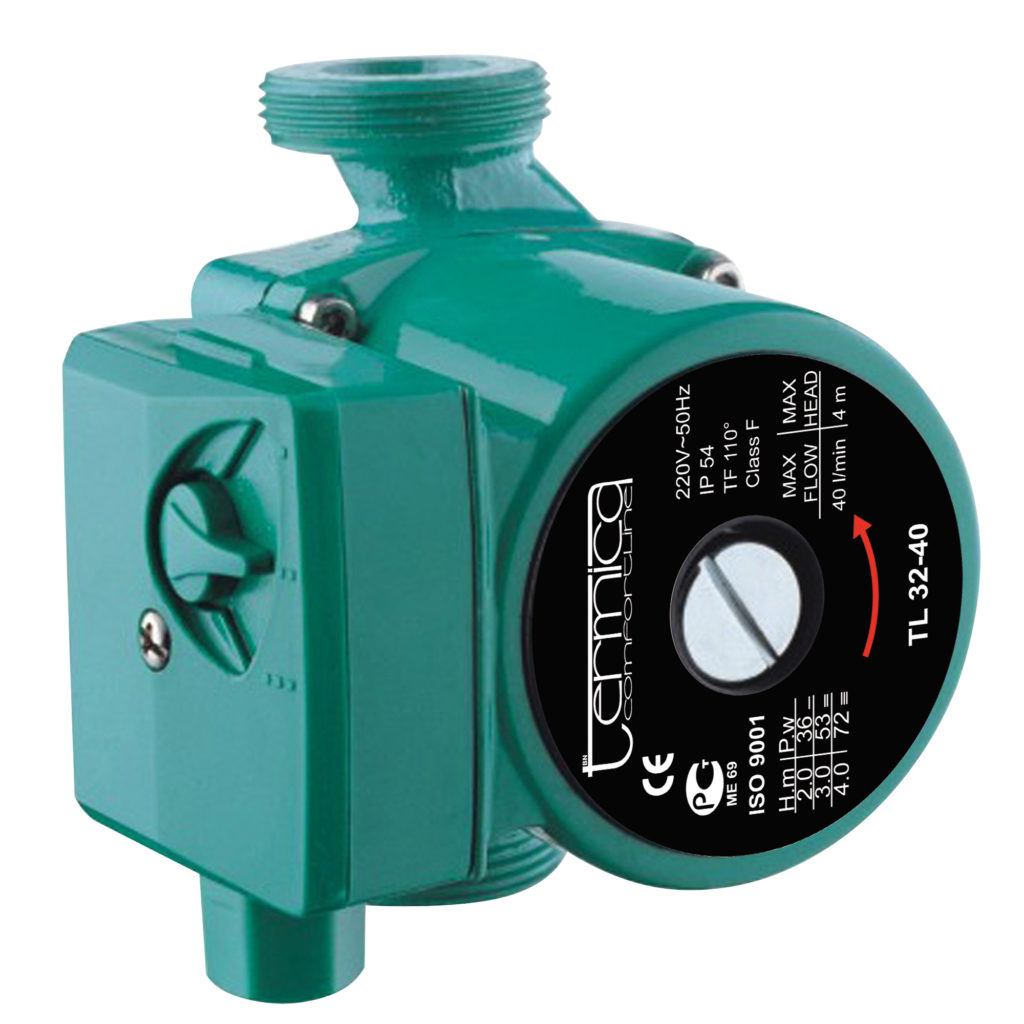
The DHW circuit must be looped over the entire length: after the plumbing fixture distant from the water heater, the bottling returns to the starting point. But the connection diagram of the water heater depends on whether it has an additional outlet for recirculation.

Is it possible to use a conventional boiler with two outputs in such a circuit (for domestic hot water and cold water)? Yes, but in this case, the wiring will be noticeably more difficult.
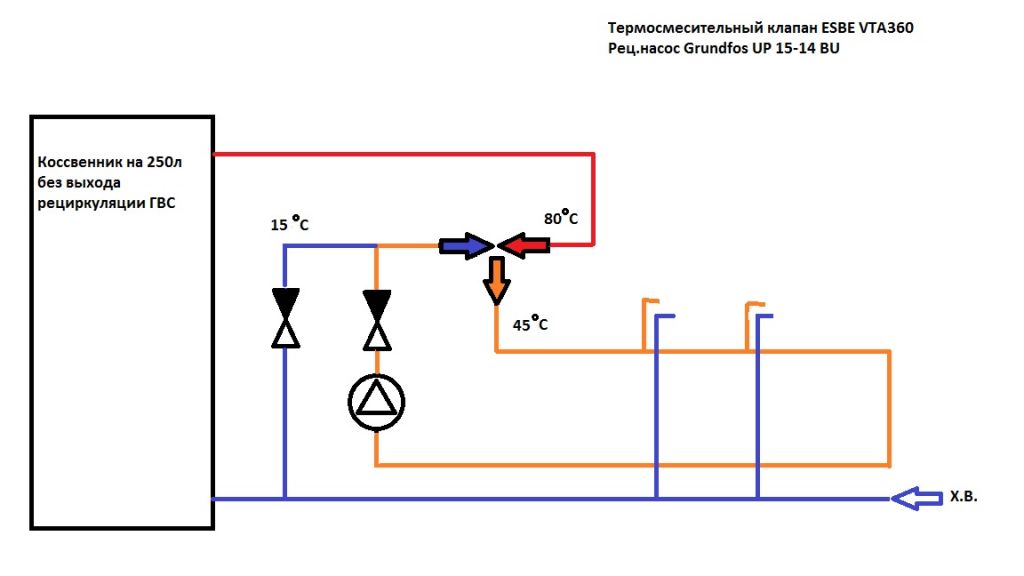
- A three-way thermostatic mixer is responsible for the constant temperature of the water in the recirculation circuit. As it cools, it mixes hot water from the boiler;

- To compensate for the flow of hot water, cold water is supplied to the three-way mixer;
- Check valves limit the movement of water in the circuit in one direction, regardless of its flow rate.
Useful: it makes sense to install an automatic air vent at the top of the DHW circuit. Air plugs in the presence of a pump will not interfere with circulation, but they can become a source of annoying hydraulic noise.
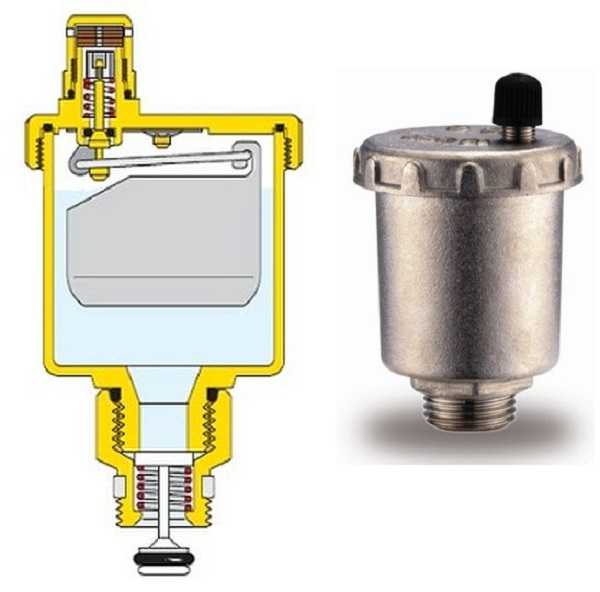
Conclusion
As you can see, hot water recirculation systems for a private house have quite convincing advantages over the usual deadlock schemes and are quite simple to install. The video in this article will help you learn more about them. Good luck!
Our topic today is the hot water supply system of an apartment building: schemes, basic elements, and typical problems that a homeowner may encounter. So let's get started.
DHW and heat supply scheme
The hot water supply scheme in an apartment building can be implemented in two fundamentally different ways:
- It uses water from a cold water main and heats it with heat from an autonomous source. It can be a boiler installed in the apartment, a geyser or a heat exchanger, using a heat carrier from a local boiler house or thermal power plant for heating;
Please note: the advantage of such a scheme is a higher quality of water. It must comply with the requirements of GOST R 51232-98 ("Drinking Water"). In addition, the parameters of hot water supply (temperature and pressure) rarely deviate from the nominal values; in particular, the d.h.w. pressure is always equal to the d.h.w. pressure, taking into account the pressure loss during tapping.
- It supplies the consumer with water directly from the heating main. This is exactly what is implemented in the vast majority of Soviet-built residential and administrative buildings, which make up 90% of the housing stock in the vastness of our great and vast. In the future, we will focus on it.

Dear reader can find additional information in the video in this article.
Items
So, what elements does the water supply scheme of an apartment building include?
Water meter unit
He is responsible for supplying cold water to the house.
The water meter performs several functions:
- Provides accounting for water flow (which is clearly reminded of its name);
- Allows you to turn off cold water throughout the house to repair valves or eliminate leakage spills;
- Carries out rough filtration of water at the entrance to the house. For this, the water meter is supplied with a mud sump.

The composition of the water meter includes:
- Entrance and house shutoff valves (valves or ball valves located on the input side of the cold water supply and the intra-house water supply system);
- Water meter (usually mechanical);
- Mud sump (tank with a drain cock, in which, due to the slow movement of water through its volume, sand, large particles of rust and other debris settle). Often, instead of a sump, the water meter assembly is equipped with a coarse filter, in which a stainless mesh is responsible for cleaning water from debris;
- Pressure gauge or control valve for its installation;
- Optionally, the water meter can be equipped with a bypass line with its own valve or ball valve on it. The bypass opens when the water meter is disassembled for repair or calibration. At other times, it is closed and sealed by a representative of the organization - the water supplier.

Curious: "Water network", or the organization replacing it, is responsible for the status of the input of the HVS up to the first flange of the inlet valve. Water meter - the area of \u200b\u200bresponsibility of the organization serving the house.
Elevator unit
The elevator unit, or heat point also combines a number of functions:
- Responsible for the operation and adjustment of the heating system;
- Provides the house with hot water. Water (it is also the heat carrier of the heating system) is supplied to the domestic hot water system directly from the heating main;
- Allows, if necessary, to switch the DHW between the supply and return threads of the heating main. Switching is necessary, since in winter the flow temperature can reach an impressive 150 ° C, and the permissible maximum temperature of hot water is only 75 ° C.

Short lecture on physics: water is heated above the boiling point without evaporating due to overpressure in the heating main. The higher the pressure, the higher the boiling point of liquids.
The heart of the elevator unit is a water-jet elevator, through the nozzle of which hot and higher pressure water is injected from the feed into the mixing chamber filled with water from the return. Thanks to the work of the elevator, a large volume of water with a relatively low temperature passes through the heating system of the house; however, the flow rate from the feed is relatively small.

DHW connections are located between the inlet valves and the elevator. These tie-ins can be two (one on the feed and return) and four (two on each thread). The first scheme is typical for houses built in the 70s of the last century and older buildings, the second - for more or less modern buildings.
Why do we need extra tie-ins?
To answer this question, we need to go ahead and study the water supply schemes in apartment buildings.
In cold water, a dead-end scheme is always used: the water meter goes into a single filling, the one into the risers, which end with in-house pipelines. Water moves in such a water supply circuit only during tapping.
And what's going on in the hot water supply?
In houses with two hot water connections to the elevator unit, the same scheme is used.

However, she has two rather annoying flaws:
- If there has been no drawdown in your riser for a long time, you have to drain the water for a long time before it heats up;
Note: if there are mechanical meters on your eyeliners, they will record water flow, ignoring its temperature. As a result, you will monthly overpay a hundred or two rubles for a service that you have not actually used.
- Towel dryers installed on the hot water supply lines, which are responsible for heating the bathroom at the same time, will only heat up when the hot water in your apartment is parsed. And, accordingly, most of the time they will remain cold. Hence, the cold and damp in the bathrooms, often becoming the cause of the appearance of the fungus.
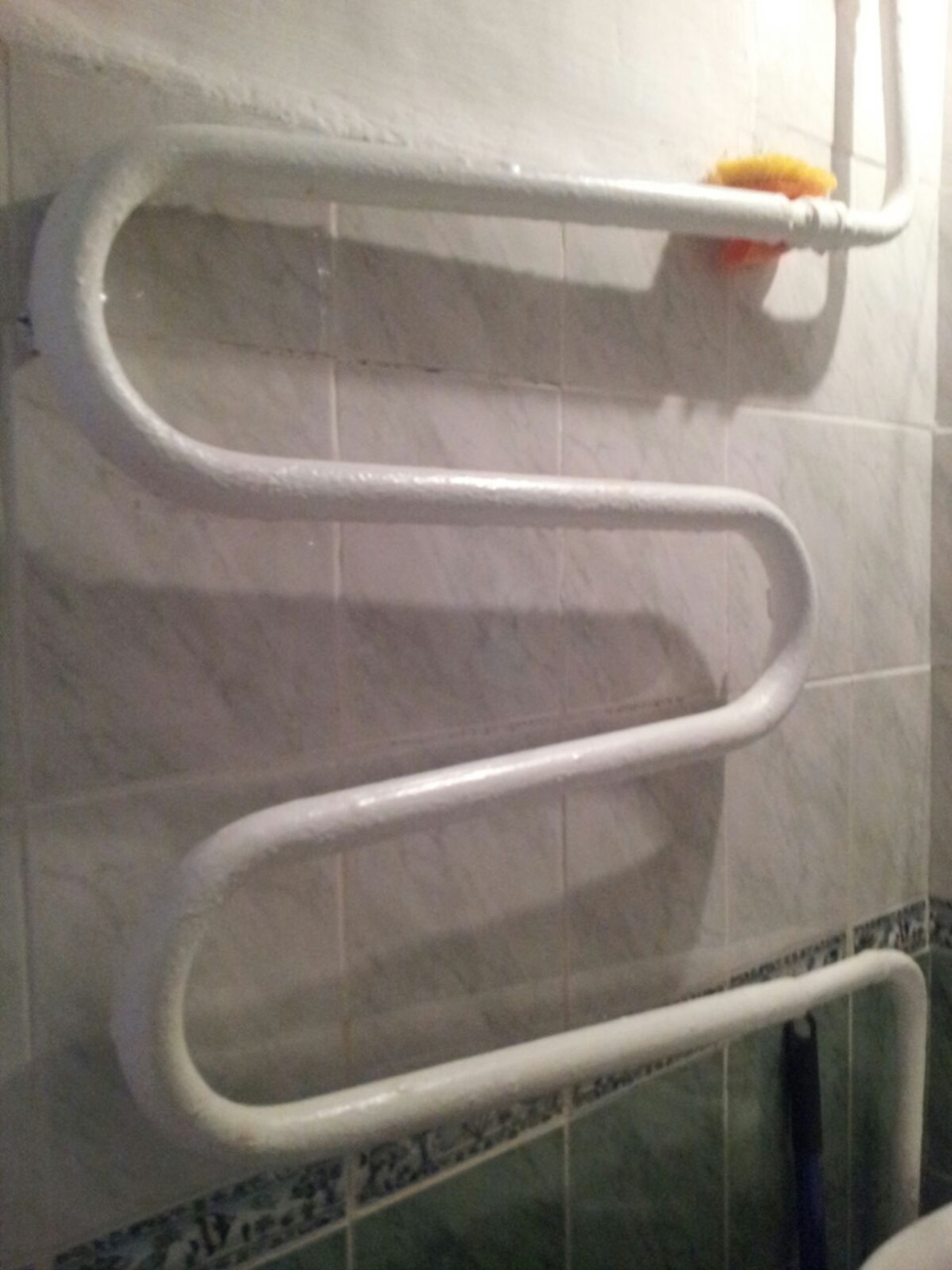
An elevator unit with four hot water inlets ensures continuous circulation of hot water through two spouts and risers connected by jumpers.
DHW operation is possible according to one of three schemes:
- From the feed to the return pipe. Such a hot water supply scheme for a multi-storey building is used only in the summer when the heating is turned off: a bypass between the heating lines would reduce the pressure drop across the elevator;
- From feed to feed. This scheme is for autumn and spring with their relatively low supply temperature;
- From return to return. So the hot water supply is switched on during the cold weather when the supply temperature exceeds the threshold 75 degrees.

Readers who have not forgotten the fundamentals of physics will have a reasonable question: how is the pressure differential necessary for continuous circulation between two tie-ins in one thread?
Remember: water moves continuously through pipes between the inlet valves and the elevator. To create a pressure drop, you only need to limit the flow to the obstacle installed between the insets. This role is played by a retaining washer - a metal pancake with a hole in it.
Captain Evidence suggests that a significant restriction in the passage of any pipeline would interfere with the operation of the elevator unit, so the diameter of the retaining washers is a millimeter larger than the diameter of the elevator nozzle. That, in turn, is calculated by the organization (heat supplier) so that the return temperature at the outlet of the heat point corresponds to the temperature schedule.
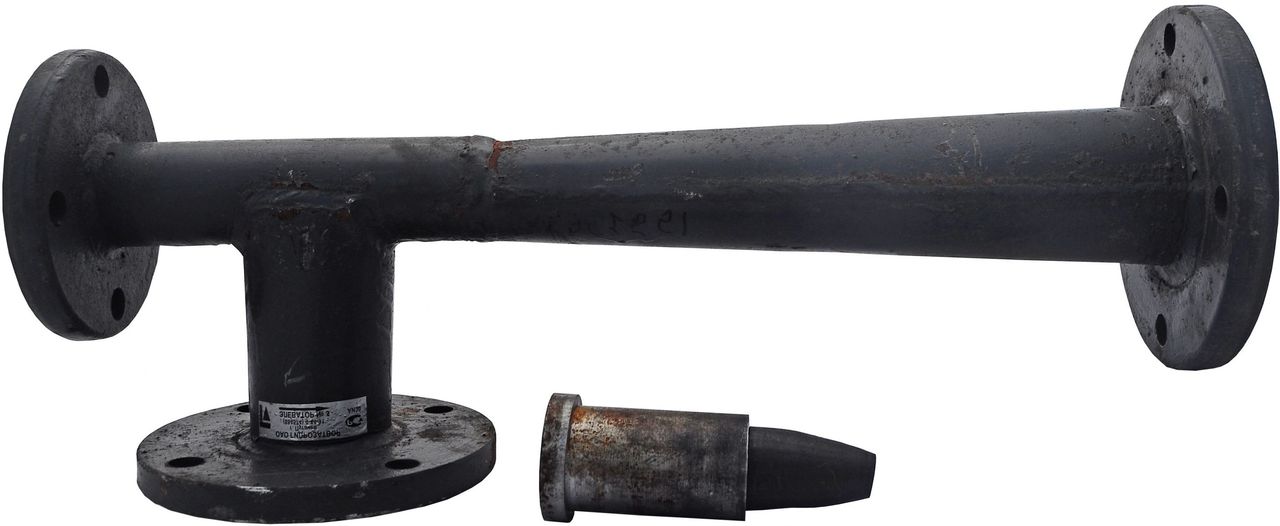
Bottling
Water supply bottoms are horizontal pipes running through the basement or underground floor of a house and connecting risers to the elevator and water gauge nodes. Hot water bottling is always one, hot water bottling in the circulating hot water supply system is two.
The diameter of the filling, depending on its material and the number of water consumers, varies from 32 to 100 millimeters. The latter value is clearly redundant; however, the water supply project of the apartment building had to take into account not only the current state of the pipelines, but also their inevitable overgrowth of deposits and rust. After 20-25 years of operation, the lumen of the pipe in cold water is reduced by 2-3 times.
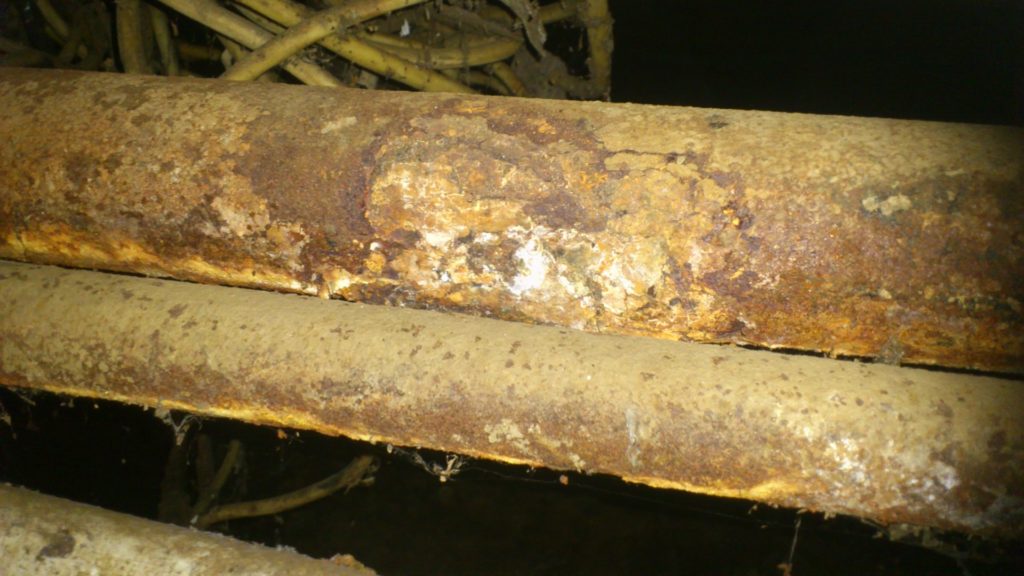
Risers
Each riser is responsible for the vertical distribution of water in apartments located one above the other.
The most typical scheme is one group of risers (hot water and hot water, optionally heated towel rails) per apartment; however, other options are possible:
- Two groups of risers can pass through the apartment, supplying water to the bathroom and kitchen spaced out over a long distance;
- The risers in one apartment can supply water not only to its residents, but also to neighbors behind the wall;
- On hot water supply, up to 7 risers from several apartments can be combined with circulation jumpers.
The typical diameter of the risers of cold water and hot water is 25-40 mm. The diameter of the risers of heated towel rails and the idle (without plumbing fixtures) circulating risers are usually smaller: they are mounted by a pipe ДУ20.
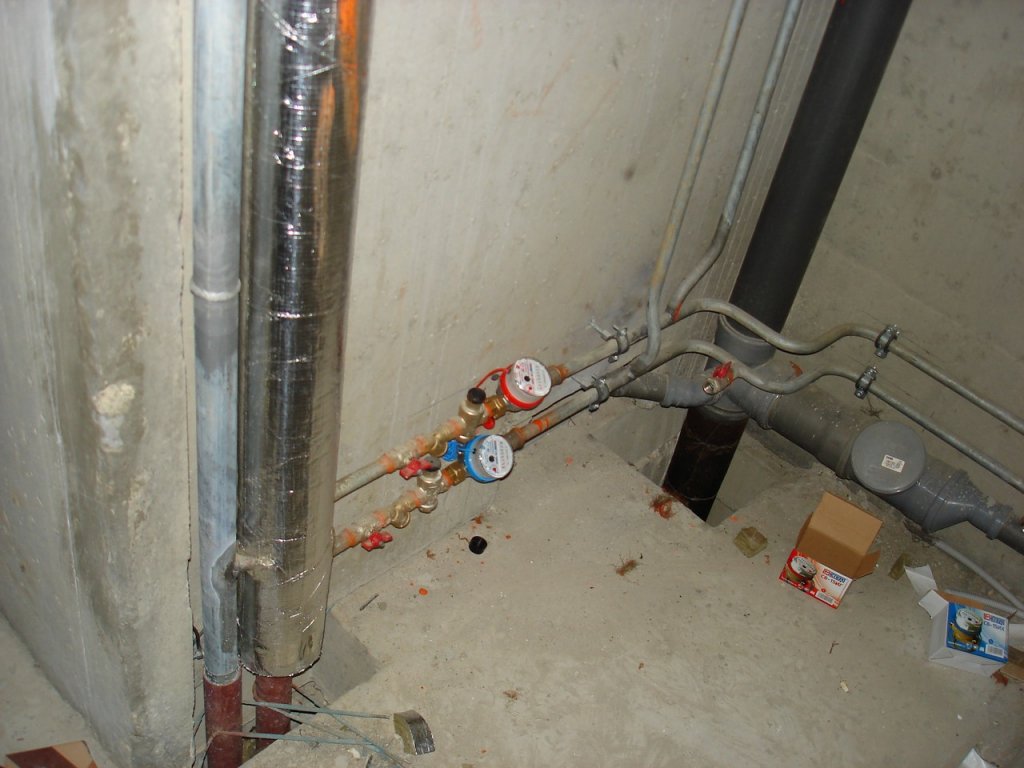
In the circulation scheme of hot water supply, jumpers between risers can be located in an apartment on the top floor or taken out to the attic. The jumpers are equipped with air vents (Mayevsky taps or conventional taps), which allow the air to obstruct circulation to be vented.
Eyeliner
Their function is to distribute water through plumbing fixtures inside the apartment. What is useful to know about water connections?
- Their typical size (for steel water pipes) is DN15 (which roughly corresponds to an internal diameter of 15 mm). When replacing eyeliners with your own hands, it is advisable not to reduce their inner diameter - this will lead to a drop in pressure on all plumbing fixtures when analyzing water on one of them;

- Since Soviet times, apartments have traditionally used simple and cheap serial (tee) wiring. A more material-intensive collector requires, among other things, hidden installation of eyeliners, which greatly complicates their further maintenance;
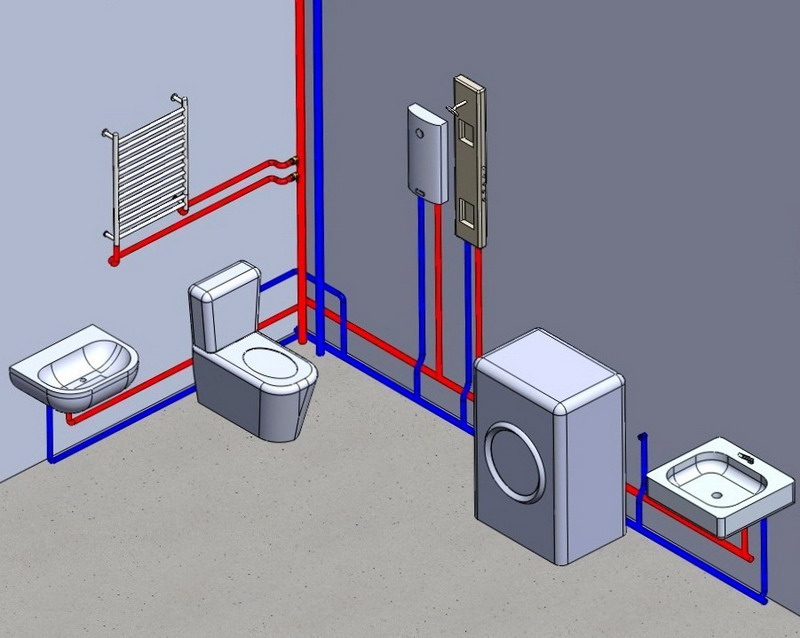
- Over time, the throughput capacity of steel hoses drops noticeably, due to the notorious overgrowth of deposits. In such cases, the pipes are cleaned with a thin steel string or, simply, replaced with new ones.

If you decide to replace the eyeliner, we strongly recommend that you opt for metal pipes. The instruction is associated with a rather high probability of water hammer and deviations from the standard temperature in the DHW system: for example, if a forgetful locksmith does not switch the water supply from the supply to the return during the first frosts, the water temperature can significantly exceed the maximum for any polymer pipes 90-95 degrees.
Which pipes can be used on water supply:
| Picture | Description |
|
|
used for wiring water supply since the time of stalinok. Unlike black steel, galvanizing is not afraid of deposits and rust. An important point: galvanization is mounted only on threaded joints, since during welding zinc in the weld area completely evaporates. |
|
|
have long proven their reliability and durability: the oldest existing copper water pipes for more than a century, and they are in excellent condition. Soldered connections of copper pipes are maintenance-free and can be mounted hidden, in screed or gates. |
|
|
Corrugated stainless steel pipes compares favorably with their competitors by extremely simple installation. To connect them, compression fittings are used, for the assembly of which only two adjustable spanners are needed. The service life of the pipes themselves is characterized by manufacturers as unlimited; however, after 30 years, you or, more likely, your children will have to change the silicone sealing rings in the fittings. |
Malfunctions
What violations in the operation of the water supply system can the owner of the apartment fix on his own? Here are some common situations.
Valve leak
Description: Flow over the stem of screw valves.
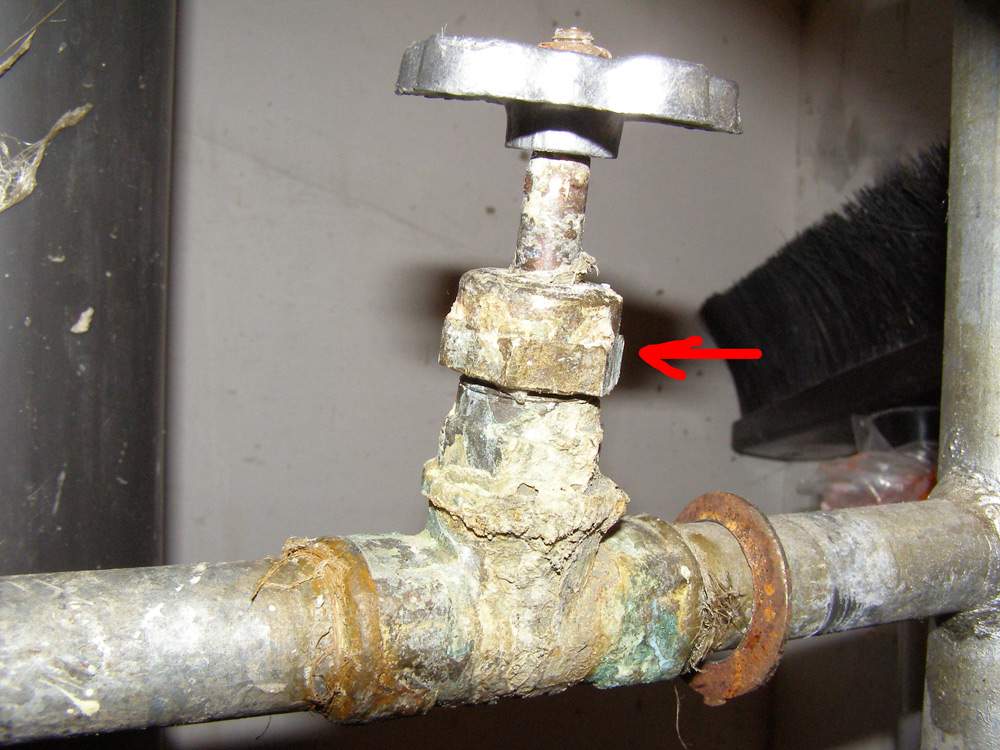
- Reason: partial gland packing or wear of the rubber o-ring.
- Solution: open the valve wing all the way. In this case, the thread on the rod will press the gland from below, and the flow will stop.
Crane noise
Description: When you open a tap of hot or (less commonly) cold water, loud noise is heard and the mixer is vibrating. Alternatively, the noise from your neighbors could be a crane.

Reason: A deformed and crushed gasket on a screw crankbox in a half-open position causes a continuous series of water hammer. Its valve with a frequency of a fraction of a second overlaps the seat in the mixer housing. The pressure on hot water, as a rule, is noticeably greater, so the effect on it is more pronounced.
Decision:
- Turn off the water to the apartment;
- Turn out a problem kranbuksu;
- Replace gasket with a new one;
- Chamfer the new gasket with scissors. The chamfer eliminates the runout of the valve in a turbulent stream of water in the future.

By the way: ceramic crane boxes are fully compatible with screw threads, and are devoid of the described problem.
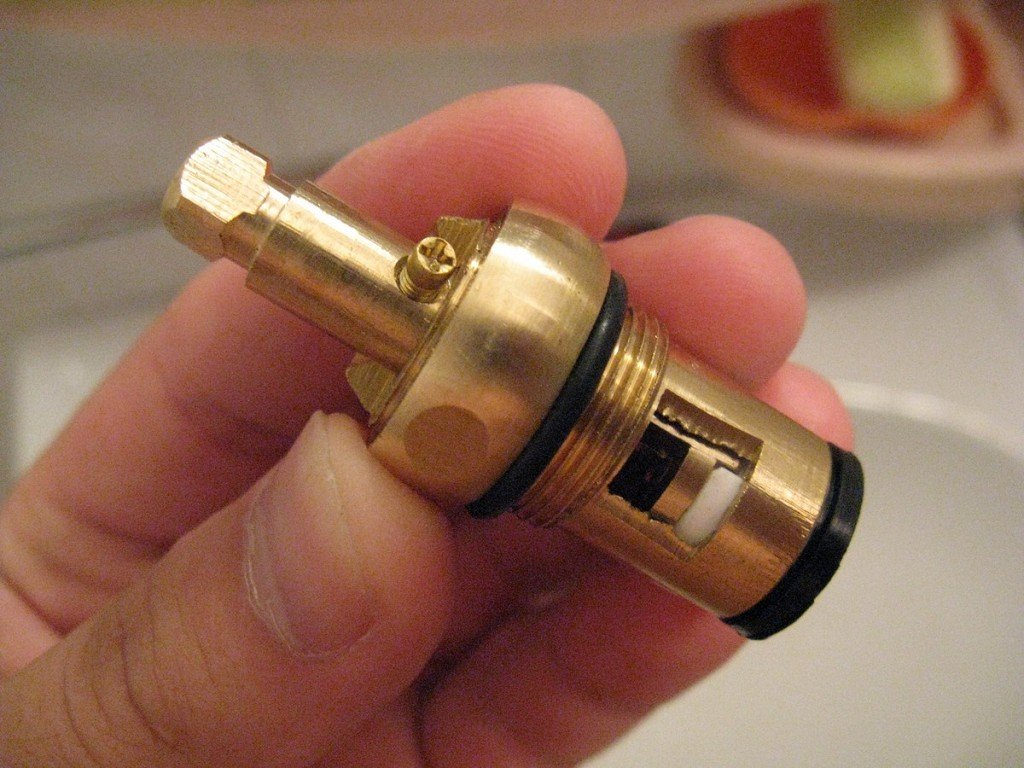
Cold heated towel rail
- Description: The heated towel rail in your bathroom is cold and does not heat up.
- Cause: if the water supply scheme of a residential apartment building uses continuous circulation of hot water, the air remaining in the jumper between the risers after the water discharge is to blame (for example, for the inspection and repair of shutoff valves).
- Decision: go upstairs and ask your neighbors to bleed air from the bridge between the DHW risers and the heated towel rails.
If for some reason this cannot be done, the problem can be solved from the basement:
- Block the DHW riser passing through your apartment to which your eyeliners are connected;
- Climb into the apartment and open to the limit hot water taps;
- After all air comes out of the riser through them, close the taps and open the crane on the riser.
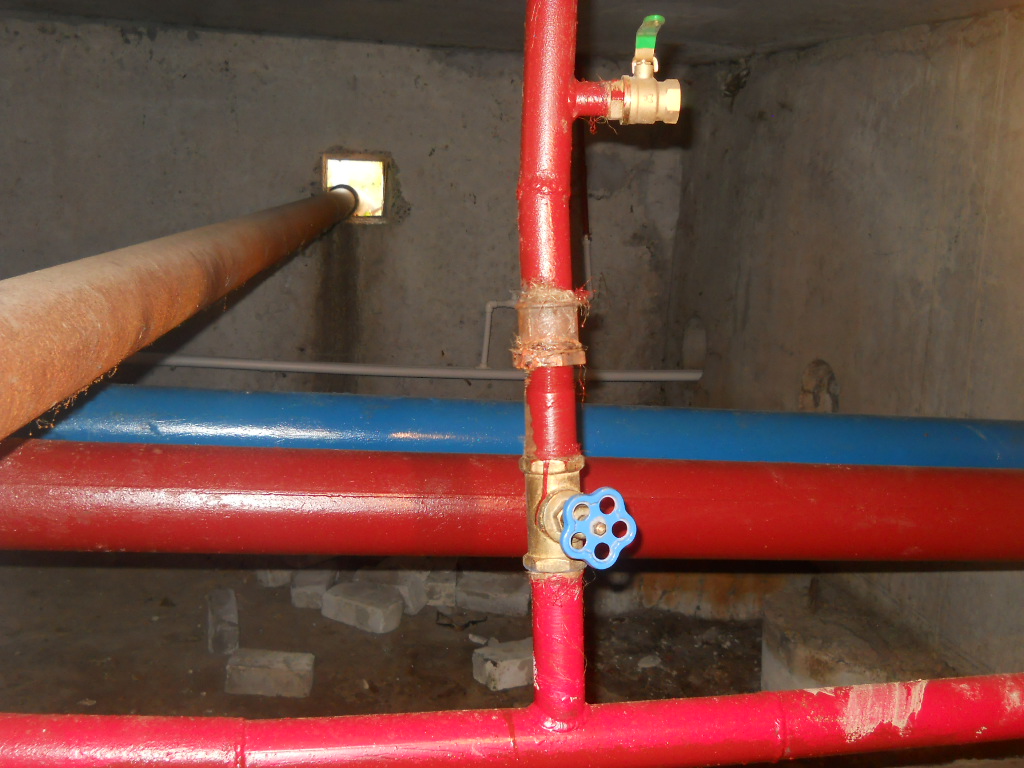
Nuance: immediately after the end of the heating season, there can be no pressure difference between the heating mains. In this case, the towel warmers will be cold even if there are no air jams in the risers.

Conclusion
We hope that our material helped you study the water supply of an apartment building: the water supply scheme described by us is the most common. Good luck!
Since the water supply system is closely connected with the heating system, we decided to entrust its design and installation to the same Teploservice company (see). Because the company positions itself as a professional in heating and water supply, we hoped that there would be no problems. However, everything was not so simple.
It seems that the company is hiring migrant workers who are not very familiar with the construction business. A foreman was assigned to monitor them, but he has many sites, and he rarely visits the site. I myself had to delve into all the nuances and daily monitor the progress of work. More than half was done poorly and was redone at my request.
Hot water recirculation (return)
If the distance from the boiler to the furthest point of the drawoff exceeds 2-3 meters (we had about 15 meters), then the organization of the return (recirculation of hot water along the highway) is desirable. The return leads to heat loss, but allows you not to wait a few minutes until the cooled water drains into the sewer.Typically, the return line is closed through a boiler, which contains a large volume of water, so that the temperature drops gradually. When the temperature drops, the boiler is connected and the boiler is heated.
It turned out, however, that the Viessmann Vitopend 100 dual-circuit boiler installed by the developer cannot be used in conjunction with a boiler. If recycling is started directly through the boiler, it will work in a very disadvantageous mode of constant on / off, because reacts precisely to the flow of water.
Brainstorming led to the following recirculation pattern:
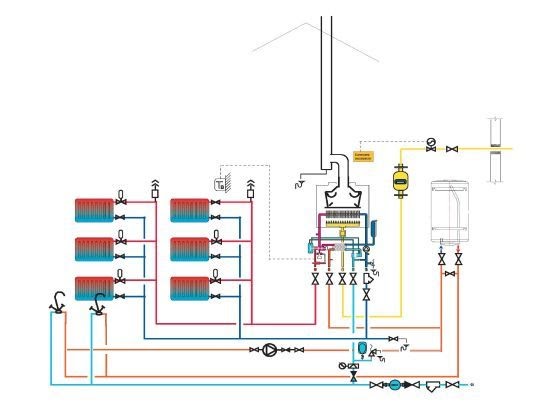
An electric boiler of the smallest volume that was found (15 liters) was purchased. Hot water from the gas boiler first passes through the boiler, and only then it disperses among consumers. Through the boiler, the return loop is looped.
The heating temperature of the electric boiler is set at 35-40 ° C, while the temperature at the outlet of the boiler is about 60 ° C. As a result, the boiler takes on the main function of water heating, and the electric boiler acts as a thermal accumulator, preventing sudden temperature jumps when the boiler is turned on / off, and also heats the return line if the temperature drops below 40 ° C.
P.S. I can’t say for sure, but something in this circuit gives a very high hydraulic resistance, presumably an electric boiler. We made one tap without return line near the boiler itself (this turned out to be a mistake), and found that the flow of hot water from it is much stronger than from the taps after the boiler.
Laying water in the house
If you have several floors, then it is worth remembering the rules for laying water pipes in multi-storey buildings: the riser first rises to the top floor, and then is distributed from top to bottom to consumers. Such a scheme allows you to compensate for the pressure drop in the riser: the distant (through the pipe) consumer is lower in the vertical. Due to this, the loss of hydraulic resistance is compensated by the pressure of the water column. Our design mistakes have led to the fact that when you open the tap on the first floor - in the shower on the third, the pressure drops to almost zero.
It is also necessary to check the ratio of the diameters of the pipes for the riser and the inlet to the devices. The exact calculation here is quite complicated (you can see, for example, here: Calculation of the diameter of the pipe using formulas for water supply), and it is advisable to entrust it to specialists, but the general principle is simple: as few pipes as possible and as large a diameter as possible. The risers are usually laid with thicker pipes, and the eyeliner to the devices is made thinner. Branches with very different hydraulic resistance should also be avoided. For example, if there are two branches of a trunk 1.5 meters and 20 meters from the boiler, then it is not surprising that when you open the tap on a short trunk at the far end, the water will barely flow. This can be compensated for by different pipe diameters.
It is advisable to protect the hot water pipe with thermal insulation. Thermal insulation of risers of a hot water supply is required.
The nozzles for mounting the shower should exit the wall perpendicularly and at a certain distance. Our wretched laborers reworked several times until they did the right thing. After that, I found a penny item in the store: a mounting bracket. This is a metal plate with holes that is attached to the wall, and fittings are already attached to it. Installation becomes much easier.
|
Grohe launches a very convenient range of faucets with thermostat. A feature of the mixer is that the water pressure is regulated with one handle, and the temperature is regulated with the other. The price range for such mixers is very high depending on the seller, however, if you search, you can find quite reasonable prices. Such a mixer should be used primarily in the shower, especially if you have a instantaneous water heater. The thermostat smooths out fluctuations in pressure in the water supply network and temperature at the outlet of the water heater. All that you feel is that the water flows more or less, but the temperature remains constant. |
|
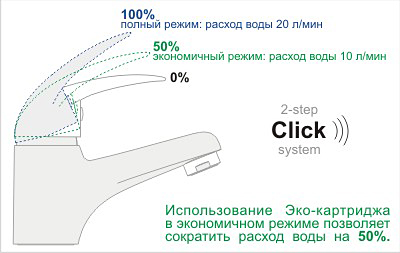
Water saving faucet
The main disadvantage of single lever mixers is their high water consumption, since in most cases a person opens it to full pressure. To save water, aerators are often worn on taps. The aerator mixes air into the water, so you get a smooth volumetric stream, pleasant to the touch. This is an easy and simple way to save water, which does not affect the usual way of life!
A mixer with an intermediate handle position, for example, from WasserKRAFT, can also be a good solution. In such mixers there is an intermediate point to overcome which you need to apply additional force, so the tap often opens halfway than full head.
Sewerage
It is necessary to ensure that all horizontal sections of the sewer go with a slope of 1-2% (1-2 cm per 1 meter). This optimal slope of self-cleaning pipes was determined by the ancient Romans. A smaller or larger slope will lead to blockages.
It is necessary to monitor this yourself, because workers are often unaware (as was the case in our case) and do as it turns out. At the construction level, there are often risks corresponding to just 1 and 2% slope.

When supplying heat, consumers often encounter low quality hot water (DHW). Typically, complaints about DHW are as follows:
· The variable temperature of hot water, the temperature changes sharply from hot to cold and vice versa, it is impossible to take a shower.
· Low temperature of hot water, it takes a long time to drain the water, or even impossible to wait for hot water.
These problems are often associated not with the source of heat supply, but with the distribution network of hot water in the house. That is, at the entrance to the house there is hot water of the desired temperature and pressure, and in the apartment the water parameters do not meet the standards.
Consider a problem with variable hot water temperature. When hot water is consumed at the required temperature, for example for showering, cold and hot water are usually mixed. The temperature will be constant provided that the water pressure does not change, if the water pressure changes, a temperature change occurs, that is, the temperature of the mixed water depends on the pressure of hot and cold water. A sharp change in water temperature is observed due to a sharp change in hot pressure and, oddly enough, the pressure of cold water. The reason for the pressure change is a change in the flow rate in the supply pipe and the presence of any “bottlenecks”. “Bottlenecks” include a partially clogged filter at the entrance to the house, an underestimated diameter of the filter or water meter, a partially clogged filter at the entrance to the apartment, a “sunken” or clogged valve in the riser. The “bottlenecks” can also be attributed to alteration of risers when a metal pipe ¾ inch (nominal diameter 20 mm) with an inner diameter of 20 mm is changed to a metal-plastic diameter of 20 mm with an inner diameter of 16 mm, while fittings with an inner diameter of 14 mm are used. The cross section of the riser is reduced by more than 2 times. A significant decrease in the cross section of pipelines also occurs on old metal pipelines with a service life of more than 15 years.
Thus, it turns out that neighbors living on different floors, opening taps of cold or hot water, draining flush tanks of toilets, change the temperature of mixed water from each other.
Methods of dealing with this are relatively simple - you need to clean the filters and check the valves on the risers, to check if there is any alteration of the common risers in the house with a decrease in diameter.
The problem with the low temperature of hot water is more complicated, because it is associated with the quality of the DHW circulation line. The circulation line is designed to prevent water cooling in pipelines. The circulation is provided by pumps installed in the central heating center (DHW), if hot water is prepared outside the house, or by pumps in an individual heating station (ITP), if hot water is prepared by heat exchangers in the house. The water flow rate in the circulation line is lower than the water flow rate when consuming hot water, since the task of the circulation line is to “refresh” hot water, to prevent cooling of the water. The cross-section of the circulation pipelines is much lower, they are designed for a constant small flow rate, and the risers are designed to pass large instantaneous flow rates while consuming hot water by several consumers.
According to the piping layout of hot water pipelines, it is possible to divide into the following types of networks:
owith lower bottling - when the hot water supply pipe is located in the basement, and the circulation (prefabricated) pipe is in the attic (technical floor),
owith top filling - when the hot water supply pipe is located in the attic (technical floor), and the circulation pipe is in the basement,
oU-shaped - when the riser rises, for example, through the kitchens, and descends into the bathrooms, the hot water supply pipe and the circulation pipe are located in the basement.
These types of networks behave differently during operation. When water moves through pipelines, the water cools, becomes denser and tends to down, the so-called natural (gravitational) circulation occurs. In networks with a lower filling, natural circulation reduces the circulation created by the pump, and in networks with a U-shaped risers and an upper filling, natural circulation helps the pump.
When the water is turned off, air enters the upper part of the pipelines and creates air plugs that stop circulation. With U-shaped risers and overflow, air can be removed through water taps, and with lower wiring, organization of air collection tanks in the attic is required. Thus, networks with U - shaped risers, an overhead filling during operation create fewer problems, but the networks with a lower filling are the most common.
The quality of the circulation line is affected by errors made at the design and installation stages of hot water pipelines. In case of networks with a bottom filling, it is necessary to provide air collecting tanks with automatic air vents, during installation, observe the slopes of the pipelines to exclude the creation of air jams.
For the normal operation of the circulation line, its balancing is necessary, that is, a uniform distribution of the circulation flow along the risers. For this, a washer or balancing valve must be installed at the end of each riser. The cross section of the washer (valve) must be designed to allow only circulation flow. The washer (valve) must be installed at the place of the insertion of the DHW riser into the circulation line. The diameter of the washer hole can be 3-5 mm, the size of the balancing valve is DN15. Installing the balancing valve is preferable to the washer, because you can quickly change the setting, and if the valve is clogged, it must be fully opened and closed to clean it.
Unfortunately, the design does not include the installation of balancing valves and balancing washers. This leads to the fact that circulation occurs only in part of the risers - in the closest risers to the hot water inlet. Consumers located at the end of the DHW riser and close to the circulation line receive water mainly from the circulation line, where the temperature is obviously 15⁰ lower than in the GVS giving line. If the supply riser is clogged or there is a “bottleneck” in it, then it is practically impossible to wait for hot water of normal temperature, since water will only come from the circulation line.
The temperature of hot water is also greatly affected by the lack of insulation on the distribution pipelines in unheated rooms, the presence of "heating floors" from the DHW system, since the DHW lines are not designed for these additional loads. The absence or malfunction of the non-return valve on the circulation pipe at the entrance to the house (or in the ITP) can lead to a decrease in the temperature of hot water during peak hours due to the reverse flow of water in the circulation pipe, a mixture of circulating water in the hot water.
For the normal operation of the DHW system, it is necessary to check the operation of the distribution pipelines and install balancing valves at the junction of the risers with the circulation pipe. Checking the operation of the supply riser is simple - you need to close the tap on the circulation pipe and check if there is hot water of normal pressure and temperature, the absence of water indicates a malfunction of the supply riser. The connection of the riser to the circulation line is checked in the same way - the tap on the supply riser is closed and it is checked whether there is water with the temperature of the circulation line and low flow (with balancing valves or washers installed), the presence of a large flow from the tap is evidence of the absence of a balancing valve or washer. Balancing valves are installed instead of shutoff valves of risers.
Conclusions: For the normal operation of the DHW system, it is necessary:
oThe absence of alterations of the risers with a decrease in diameter, the absence of "heating floors", "bottlenecks" on the distribution pipelines, the presence of slopes and air collecting tanks with air vents,
oBalancing the DHW system by installing balancing valves or washers.
The pipeline for hot centralized water supply cannot be made according to the cold water supply scheme. These pipelines are dead ends, that is, they end at the last point of drawdown. If you make a hot water supply in an apartment building in the same way, then the water at night, when it is not used much, will cool in the pipeline. In addition, there may be such a situation, for example, residents of a five-story building located on one riser went to work during the day, the water in the riser cools down and suddenly some of the tenants on the fifth floor needed hot water. After turning on the tap, you will first have to drain all the cold water from the riser, wait for warm, and then hot water - this is an excessively high consumption. Therefore, the hot water supply pipelines are looped: the water is heated in the boiler room, heating unit or boiler room and is supplied through the supply pipe to consumers and returned to the boiler room through another pipe, which in this case is called circulation.
In a centralized hot water supply system, the piping in the house is performed with double-pipe and single-pipe risers (Fig. 111).
Fig. 111. Schemes of distribution of hot water supply in centralized systems
The two-pipe hot water supply system consists of two risers, one of which delivers water, the other discharges. On the outlet circulating riser place heating devices - heated towel rails. The water was heated and supplied to consumers anyway, and whether they will use it or not and at what time is not known, so why should it disappear, let this water heat towel rails and air in raw, by definition, bathrooms. In addition, heated towel rails serve as a U-shaped compensator for temperature extension of pipes.
The one-pipe hot water supply system differs from the two-pipe system in that in it all circulation risers (within the same section of the house) are combined into one and called this riser “idle” (it does not have consumers). For better water distribution to individual points of water consumption, as well as in order to maintain the same diameters along the entire height of the building in single-pipe hot water systems, risers are looped. In the ring scheme for buildings up to 5 floors inclusive, the diameters of risers are 25 mm, and for buildings from 6 floors and above - 32 mm in diameter. Heated towel rails in a single-pipe wiring are placed on the risers, which means that with weak heating of the water in the boiler rooms, it can reach distant consumers who have cooled down. Hot water will not only be dismantled by nearby consumers, but it will also cool in their heated towel rails. In order for the water not to cool and reach hot to remote consumers, a bypass is inserted into the heated towel rails.
Two- and single-tube hot water systems can be made without heated towel rails, but then these devices must be connected to the heating system. Moreover, in the summer, towel warmers will not work, and in the winter - the total cost of hot water and heating will increase.
To ensure air removal from the system, pipes are laid with a slope of at least 0.002 to the pipeline inlet. In systems with a lower wiring, air is removed through the upper taps. At the top, air is vented through automatic air vents installed at the top of the systems.

